|
Feb
14
2022
|
|
Posted 3 years 330 days ago ago by Admin
|
|

Last year may have been a tough year for the world in general due to COVID-19, but there was still lots of good news when it came to the latest and greatest in helicopter technology. Here's what the industry achieved in 2021.
Airbus Moves Towards Hybrid Helicopters
The development of hybrid electric/gasoline cars has resulted in increased fuel efficiency and lower CO2 emissions. Airbus Helicopters is working towards the creation of hybrid helicopters, by integrating an electric motor inside its Flightlab H130 helicopter testing laboratory.
In its current configuration, the electric motor is being used to provide extra power during autorotation landings. To make this happen, Flightlab Project Director Alexandre Gierczynski explains, “The electric motor is connected into the helicopter’s main gearbox, using an intermediate reduction gearbox between the two to bring the electric motor’s 25,000 rpm speed down to the main engine’s 6,000 rpm. We also have rechargeable lithium batteries in the H130's cargo hold, with an inverter to convert their direct current into alternating current (AC) to power the electric motor and for controlling the amount of speed and torque delivered to the main motor.” In the cockpit, a control panel gives the pilot the ability to engage or disengage the electric motor as needed, plus notification to let them know that the system is working.
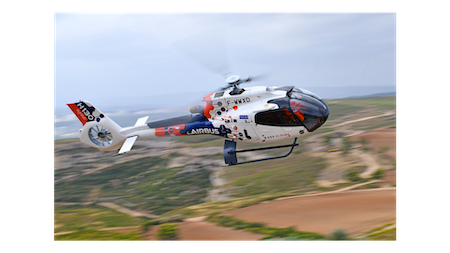
Due to the current weight and size of lithium batteries, moving to a hybrid helicopter at the present time is impractical to the impact on a helicopter’s payload capacity. However, as batteries continue to become smaller and more efficient – as has already happened in hybrid cars – this will eventually cease to be a problem.
Bell Continues Developing Its EDAT Tail Rotors
Bell spent 2021 refining its electronically distributed anti-torque (EDAT) tail rotor systems. Instead of one large tail rotor, EDAT uses four smaller ones. The new system is meant to provide helicopter pilots with more control while using advanced technology that is both simpler and quieter.
Unlike any conventional helicopter out there today, “What Bell’s EDAT provides is the ability to give the pilot some torque authority to get down safely,” said Eric Sinusas, Bell’s director of commercial development. “In a nutshell, we removed all of the conventional, mechanical anti-torque components including, gearboxes, driveshafts and tail rotor hub and blades replacing it with four electric motors and fans. They are fixed-pitch blades and they’re changing rpm constantly. Noise hasn’t really been a top priority for the helicopter industry for quite a while, but it’s quickly becoming a very important parameter.”
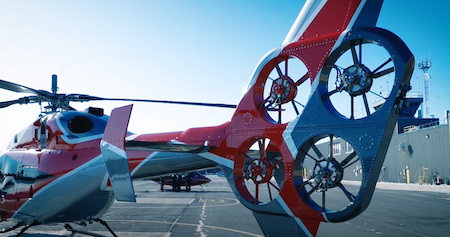
The EDAT is currently being tested on a Bell 429 demonstrator aircraft, which flies out of Bell’s facility in Mirabel, Quebec.
Leonardo’s AW609 A4 Tiltrotor Made Middle Eastern Debut
In late 2021, Leonardo Helicopters’ AW609 AC4 twin-engine tiltrotor helicopter flew to Dubai, for its first official presentation in the Middle East. Designed to be “fully representative of the final production configuration,” said a Leonardo spokesperson, the multirole AW609 A4 left Leonardo Helicopters’ headquarters in Cascina Costa di Samarate, Italy, on September 10 and landed in Dubai on September 13, following stops in Southern Europe, Northern Africa, and the Middle East. The aircraft is supported by Aerogulf and hosted in their hangar at Dubai’s Al Maktoum International Airport.
“This ferry flight set a major milestone for a tiltrotor as the AW609 is the world’s first one set to obtain civil certification,” said the Leonardo spokesperson. “Combined with this, Leonardo presented an all-new, innovative rotorcraft terminal in Dubai in early October, designated ‘Casa Agusta’.”
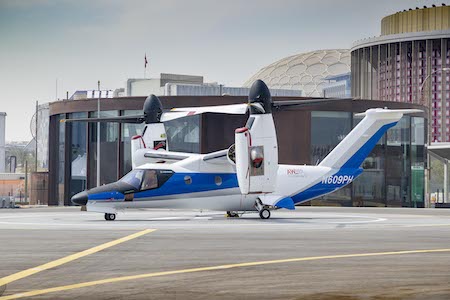
Leonardo developed the Casa Agusta terminal in partnership with UAE operator Falcon Aviation, who is supporting helicopter transport to and from the Dubai Expo 2020. (Delayed by COVID-19, the Expo 2020 world fair runs from October 1, 2021 to March 31, 2022.) Casa Agusta features a modular design that allows the terminal to be disassembled and then reassembled in other locations.
Robinson Offers 4K Video Recording System for Cockpits
Robinson Helicopters marked 2021 by launching a 4K cockpit video recording system as standard equipment on the R66 helicopter, and as a $2,500 option for the R22 and R44.
The system uses a ceiling-mounted 4K Ultra HD (3,840 x 2,160 pixels) video camera to capture a wide, high resolution record of the pilot(s), instrument panel, and forward view. The system also captures the helicopter’s intercom audio, radio communications, and GPS positions to a removable 128 GB USB flash drive.
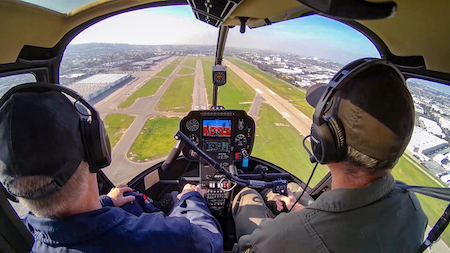
The Robinson 4K video system starts recording as soon as the helicopter is turned on and stops when it is turned off. The flash drive, which is supplied with each camera, stores approximately 10 hours of video. When the drive is full, the newest video automatically overwrites the oldest video. The 4K videos can be used as a legal record, training tool, maintenance aid, or aerial-tour souvenir that can be sold to customers.
Sikorsky’s S-70M Black Hawk Earns Commercial Certification
Having established itself in the military sector, Sikorsky’s Black Hawk helicopter is now moving into commercial aviation thanks to an FAA type certification (in the Restricted Category) and an associated pilot’s type rating. Based on the US Army’s H-60M, the first commercial S-70M Black Hawk has been acquired by San Diego Gas & Electric.
“Type certification allows commercial helicopter operators, for the first time, to purchase a new production Black Hawk helicopter from Sikorsky, a Lockheed Martin company,” said Joe Palumbo, director, Development and Capture Programs.. “The Type Rating enables commercial pilots to receive training on an FAA-approved S-70M flight simulator developed by FlightSafety International or, if qualified, their military equivalency to be type rated in the S-70M.”
The push to bring the workhorse Black Hawk into commercial service has been a long time coming. “Both domestic and international operators have asked for several years if Sikorsky had a Black Hawk with any kind of civil certification, regardless of whether the requesting operator’s country would accept the certification,” said Palumbo. To address their requests, Sikorsky applied to the FAA to amend the company’s existing S-70A Restricted Category Type Certificate to include the S-70M in 2017.
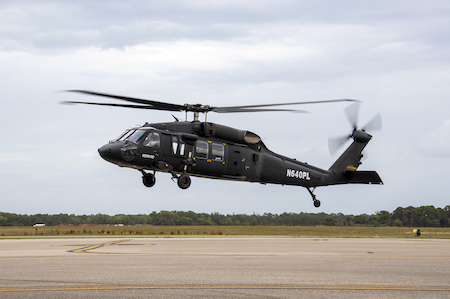
The effort paid off. “The FAA awarded Sikorsky an S-70M Type Certificate in February of 2019 (H5NE) because the company demonstrated the S-70M configuration met the prerequisites of 14 CFR 21.25(a)(2) for a restricted category aircraft type having been accepted by an Armed Force of the United States,” Palumbo said.
This certification has expanded the Black Hawk’s usage into commercial aviation missions such as agricultural operations, carrying external cargo, and various forest and wildlife conservation duties including aerial firefighting. But the S-70M will not be allowed to carry civilian passengers on a carrier-type basis, since the original military helicopter was never designed to meet those standards.
This being noted, “This restriction has not prevented keen interest by commercial operators wishing to possess the latest version of the Black Hawk, which they can now purchase directly from the factory,” said Palumbo. Previous to this, most Black Hawks in commercial operation were ‘pre-owned’ military H-60 airframes acquired from the U.S. military.
“Several countries won’t allow surplus military aircraft to operate in their airspace system,” Palumbo noted. “For those regions that want the Black Hawk and its capabilities for emergency services, the new build S-70M fully answers that need with the opportunity to meet or exceed each country’s regulatory structure.” The new S-70Ms are being made by PZL Mielec, a Lockheed Martin company, at its production facility in Poland.
“S-70M will become the standard designation for Black Hawk aircraft produced for direct commercial sale,” Palumbo added. “However, customers wanting S-70i aircraft will still be able to procure them. With the exception of optional non-STC mission system/equipment available for the S-70i, both aircraft types are identical.”
SKYTRAC Transmits Real-Time Medical Data from STAR Helicopter
In 2021, connectivity solution provider SKYTRAC Systems (SKYTRAC) and STARS Air Ambulance achieved in a flight trial the first-of-its-kind medical data transfer from STARS' new five-blade Airbus H145-D3 aircraft to a ground station. This means that receiving hospitals will be able to access complete real-time patient status from air ambulances while the patient is en route. In addition, receiving centers can prepare and analyze data well in advance of the patient’s arrival, saving valuable seconds during one of the riskiest phases of care, which can mean the difference between life and death.”
"The onboard ZOLL X Series monitor/defibrillator captures patient vitals such as oxygen and carbon dioxide saturation, pulse rate, and blood pressure." said Mandi Skinner, STARS' regional business manager. "The device has been successfully configured to connect to an onboard Wi-Fi network enabled by SKYTRAC's DAL-200. When cellular connectivity is available, the DAL-200 enables the ZOLL X Series to connect to its own servers. When cellular connectivity is not available, as is the case for most remote EMS missions, SKYTRAC's ISAT-200A encrypts and transmits medical data through the Iridium satellite network to SKYTRAC, where it is then forwarded to ZOLL's secure medical servers."
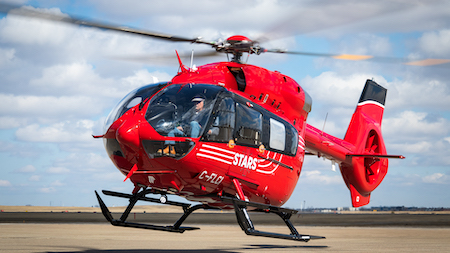
"While STARS transport physicians have been virtually present through the telephone, this provides them a better picture and enables them to assist the onboard air medical crews even more so," she added. "This means the receiving centers can prepare and analyze data well in advance of the patient's arrival, saving valuable seconds during one of the riskiest phases of care which can mean the difference between life and death."
Vita Rescue System Keeps Litters Stable
The need to stabilize and stop rotation in helicopter-hoisted patient litters is an ongoing headache for air EMS crews. The Vita Rescuer System, which is designed to work with all major rescue kits, terminates this problem by attaching a frame with a pair of horizontally mounted, counterthrusting electric, ducted fans on either side of the litter.

“The system uses a proprietary software suite to sense the environment, interpret the data from the environment, and power the counter thrusts as needed to prevent swing and spin, or to ‘fly’ the litter off-center to perform vertical rescues,” explained Vita Inclinata Chief of Staff Lillian Hoffer Long. “The attachment provides stabilization to prevent swing and spin, direct control to position the kit as needed for ease of use and efficiency to hoist a patient into an aircraft cabin, and flight control to horizontally fly the hoist off-center outside the diameter of the rotor blades to conduct vertical obstruction rescues such as high-rise tower, mountain or cliff-side, and ship side.” Learn more at https://vitatech.co/products-rescuesystem/.
READ MORE OF THE NOV/DEC ISSUE